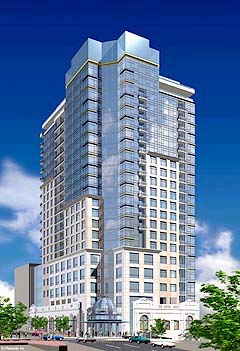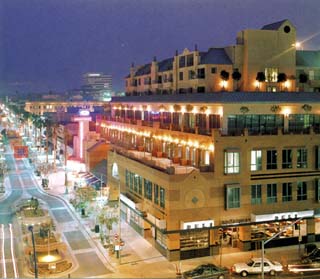
DJC.COM
August 9, 2001
The future is looking UP
Weber + Thompson

Rendering by Weber + Thompson Crystal Pool is a high-rise proposed near Pike Place Market. Its 192 condos, along with restaurant and retail space, will help strengthen the urban village qualities of downtown Seattle. |
Something called urban sprawl happened on the way to the American Dream. Time once spent enjoying the richness of family, neighborhood and community is lost to solitary time behind a steering wheel — traffic congestion is now cited by most Americans as the most frustrating aspect of daily life.
Traffic, however, is not the only sprawl-induced frustration that comes with unrestrained horizontal development. Over-taxed infrastructure, biological degradation, visual blight and energy shortages have reached a crisis point. At a rate of 2 million acres per year — in some areas up to one acre per hour — our prime farmlands and wooded open spaces are being voraciously consumed.
The good news is that in many areas of the West Coast, we are taking very positive steps toward smart growth. There is a paradigm shift — a new urbanism — in our thinking about how we will house ourselves in the future. In Oregon and Washington, municipalities are drawing lines in the clay, establishing boundaries to restrain growth and preserve precious farmland and open space.

Weber |
Innovative programs such as King County’s transfer of development credit (TDC) programs allocate development rights from county open space and farmland into urban centers that are equipped to handle greater density. In California, failed malls and dying town centers are given new life with an infusion of high-density housing.
It is an established fact that higher densities help to foster viable urban villages. The best part of this notion is it is a win-win situation both for the state in preserving agricultural parcels and wetlands, and for urban centers in receiving higher densities vital to their success.
6 trends
One of the most essential characteristics of these urban villages will be high-density, vertical, mixed-use housing. At least six identifiable trends will influence a proliferation of vertical housing where a good many of us will call home.
Living closer to work

Photo courtesy of Weber + Thompson In Santa Monica, Calif., Janns Court @ Third Street Mall has been credited with helping to turn a failed open-air mall into an urban village. |
U.S. population will grow by 63 million people by the year 2025. Even if plans for mass transit initiatives meet the best of expectations, increasing population will ensure that traffic will continue to worsen each year. With over half of us now living in the suburbs, the average commuter wastes over 500 hours annually stuck in slow moving traffic. The national economic impact of traffic delays is estimated to exceed $72 billion annually.
However, our transportation problem is more than economical, it affects our mental health due to physical exhaustion and increased stress.
The most logical response to worsening traffic is to shorten the commute by living closer to our places of work. For many, this means greater acceptance of living in the city.
New lifestyle choices
A major shift in our population demographics has been in progress during the last decade. There is a growing faction of childless couples, single people, unmarried roommates, single parents and empty-nest parents. These groups now comprise a 75 percent majority over the traditional nuclear family. This new majority of our population no longer demands the suburban three-bedroom, picket fence lifestyle. These individuals are more inclined to appreciate high-density and in-city living — especially in areas that provide walkable conveniences that exist side by side.
| 5 high-density projects designed to help vitalize urban villages |
|
Crystal Pool, Seattle — A mixed-use, 22-story, high-rise project designed by Weber + Thompson and developed by Crystal Pool Inc. The project will contain 77,000 square feet of office space, 192 high-end condominium units and 7,700 square feet of restaurant and retail space at street level. Located near Pike Place Market and the retail core, the project will help strengthen the urban village qualities of a rapidly changing downtown Seattle.
The Neptune, Seattle — An eight-story, mixed-use project designed by Weber + Thompson and developed by Simpson Housing Limited Partnership. This 378,000-square-foot, mixed-use, largely residential project will help to establish an urban village neighborhood in this Lake Union area that is currently comprised primarily of office and commercial uses. A total of 222 residential housing units will be constructed over 20,000 square feet of retail space, live/work units, and 324 sub-grade parking stalls. The project recently won a Livability Award from 1000 Friends of Washington, the only statewide non-profit organization solely dedicated to bringing citizens together to manage growth and stop sprawl in Washington. 1000 Friends fosters vital communities by encouraging compact, transit-friendly and walkable neighborhoods. Paseo Pasadena, Pasadena, Calif. — A makeover of a 700,000-square-foot shopping center into a three-block urban village/entertainment center designed by Ehrenkrantz, Eckstut & Kuhn Architects and developed by TrizecHahn. The project will include 400 loft-style residential units over a mix of retail, entertainment, office and restaurant space. The project is expected to create a pedestrian connection to Old Pasadena, a turn-around success story in its own right, due to a pedestrian-focused revitalization effort that recycled neglected older buildings into movie theaters, retail and new housing. Janns Court @ Third Street Mall, Santa Monica, Calif. — Designed by Johannes Van Tilburg and developed by Janns Corp., the project contains 60,000 square feet of office space, 66 condominium units, 32 market rate rental units, two restaurants and a four-screen theater. Janns Court, a mixed-use structure, is credited with initiating the turnaround of a failed open-air mall into an urban village and for jump-starting the revitalization of downtown Santa Monica. Brea Town Center, Brea, Calif. — A new urban village town center designed by RTKL and developed by CIM Group LLC. Its 22 movie screens will complement over 400,000 square feet of retail stores and restaurants, 96 detached houses, 40 townhouses and 62 loft apartments. In an effort to integrate the project into the civic whole, careful attention is paid to creating a true pedestrian environment. Currently under construction, over 70 percent of the project has been pre-leased, a testament to the confidence many have in the urban village concept. |
The expense of heating and cooling our homes and the cost of filling our gas tanks will consume an increasing piece of our budget pie. The cost of housing itself will outpace inflation thanks to escalation in the cost of land, the cost of entitlement and the onerous cost of project mitigation. The result: many renters and home buyers will be willing to accept less square footage and higher density in their housing accommodations, in order to stretch their budgets and to preserve disposable income. There is a trend toward quality over quantity, as people seek to elevate their lifestyle.
Downsizing will become more acceptable as energy costs escalate, housing costs outpace the rate of inflation, and as people continue to adjust their lifestyle choices.
In-city living
Thanks to sensitive urban planning that helps to create pedestrian-focused and village-like neighborhoods, many of our cities have and will continue to become vibrant and livable communities.
In-city living will afford more of the free time that is such a precious commodity thanks to the frenetic, technology-driven pace at which most of us live. For many, there will be a rebellion against the lifestyle that has made us slaves to our houses. In-city perks include cultural, recreational, and culinary venues found only in the urban core. The future of many cities and towns includes the development of new entertainment centers, new linear parks and town squares, and a renaissance of cultural, sporting, and recreational events that are walkable. For many, living in the city will become the lifestyle of choice.
Higher densities
In order to ensure a healthy environment and minimize impacts caused by sprawl, it must be recognized that the amount of developable land is finite. New Urbanism planners, architects and developers promote higher density in urban centers in conjunction with restrictions on sprawl.
Washington State’s Growth Management Act restricts urban sprawl that taxes our environment and contributes to traffic and infrastructure problems. At a time when the cost of developing raw land has become almost prohibitive, all of this adds up to a trend that is supported by state and local governments: to shift new housing and higher densities into urban centers.
A return to village living
In-city environments that combine working, living, eating, socializing and recreation uses will become more commonplace in the future. Many of us will live “above the store” in high-density, mixed-use buildings that juxtapose offices, retail stores, restaurants, health clubs/spas, entertainment facilities, business and support services that are mutually supportive. Modern urban village living will afford many the uniquely rich and culturally rewarding lifestyle found only in our cities and town centers.

Rendering by Weber + Thompson With 222 housing units, the Neptune is expected to help establish an urban village neighborhood in the south Lake Union area of Seattle. |
America is at a crossroads. The path we are on ensures a future of gridlocked highways and a decline in the quality of our lives. The other fork in the road takes us to high-density village communities designed for the real needs of people.
The neighborhood of the future is a pedestrian-focused village environment that engages us into all of the conveniences and special pleasures of in-city living. The city of the future turns out to be much like the old neighborhood, with a bit more verticality.
Planners, architects and developers must embrace vertical density, designing and building projects based on good urban design principles and thoughtful recognition of the importance of neighborhood. The result will be vibrant, livable urban villages that help mitigate the impact of sprawl, where a good many of us will be living in the sky, above the store. The future is indeed, looking up.
Blaine Weber, AIA, is a principal at Weber + Thompson, a Seattle-based architectural and interior design firm specializing in mixed-use and high-rise projects. Weber is a member of The Congress for the New Urbanism, The Urban Land Institute, and is a contributing editor to Skyscrapers.com. He has 30 years of experience in the design of high-rise structures and he is currently writing a book about high-rise dwellings entitled “Living in the Sky.”
Other Stories:
- Pricing gridlock out of the market
- Urban form gets its roots from nature
- Downtown becomes a shopping mecca
- Earth-shaking discoveries impact design
- The scoop on infill development
- Infill problems? Get creative
- Rubbernecking leads urban retail revival
- Rx for Seattle’s growing pains: Collaboration
- DSA puts a downtown neighborhood on the ‘Edge’
- Public places — look between the buildings
- A blast from the past — modernism is back
- Getting the ball rolling with affordable housing
- Energizing Everett
- Urban development versus the public process
- Protecting views makes sense from every angle
- Urban development picture includes artists
- Retail? Start with the first floor
Copyright ©2009 Seattle Daily Journal and DJC.COM.
Comments? Questions? Contact us.